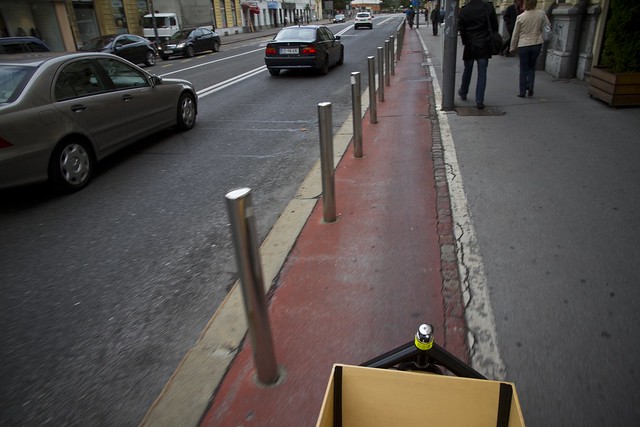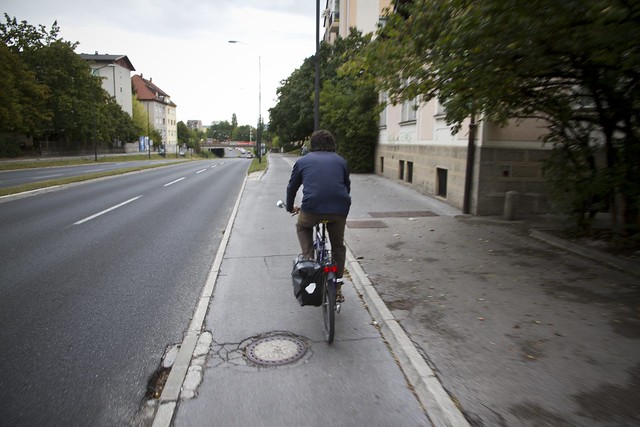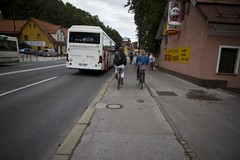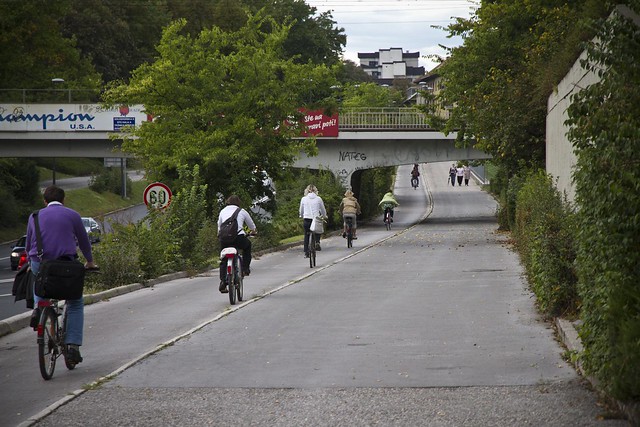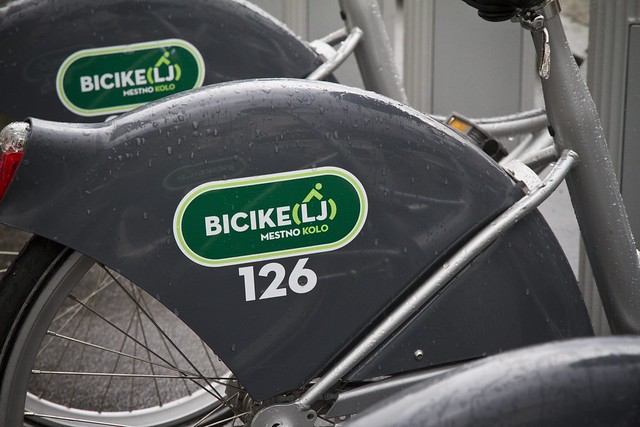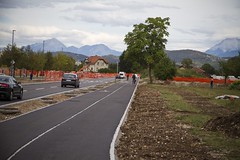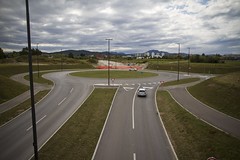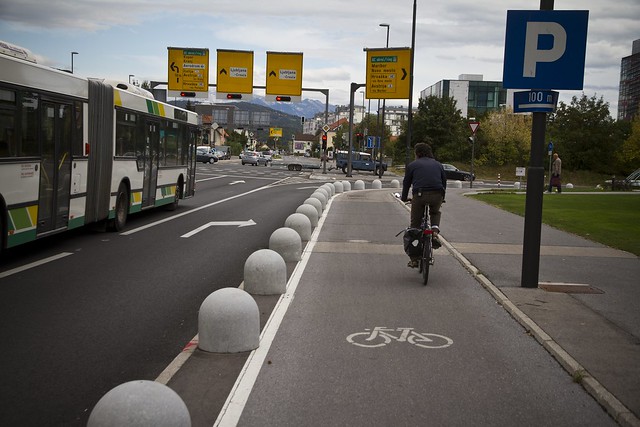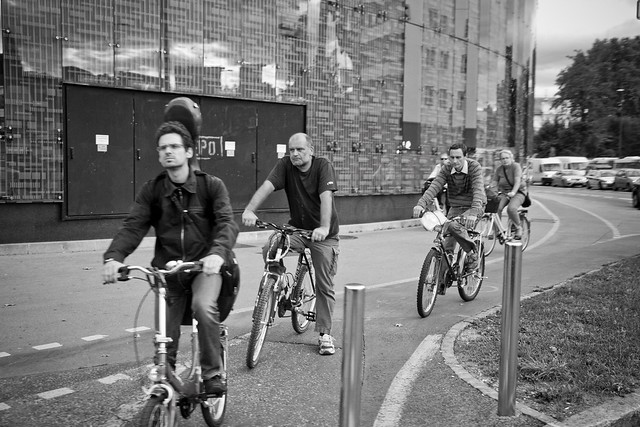

I felt at home on my recent visit to Ljubljana, Slovenia. Arriving from Copenhagen in a city with 10% modal share for bicycles is always a pleasure. I was attending to three bits of business. Opening European Mobility Week at the Foreign Ministry with the Danish Ambassador and the Slovenian Foreign Minister, giving my Four Goals for Promoting Urban Cycling talk at the City Museum and opening the world premiere of my Monumental Motion exhibition. A busy but thrilling and rewarding couple of days. Inbetween gigs I cycled around the city with my friend Janez, Ljubljana’s Cycling Officer and some urban planning colleagues.
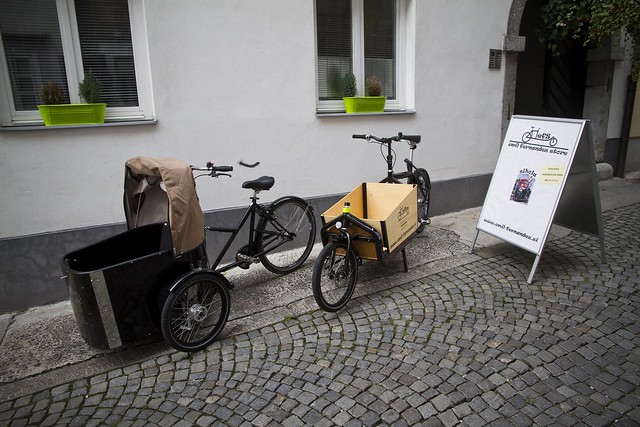
I was given a Bullitt to ride so I felt even more at home, although the Nihola would have done it, too. Thanks to Miha at Emil Hernandez for the loan. The goal of the cycle ride around the city was to look at some problems in the bicycle infrastructure network and to see what we could do about it. With 10% modal share, I knew that there was decent infrastructure in place. We started in the city centre with some infrastructure that was... well... interesting. We headed out to the near suburbs, towards a "problem intersection" that needed some Copenhagenizing. It was on the way out there that I looked down. And saw something quite lovely. I speed up alongside Janez and asked him what the hell we were cycling on. It looked remarkably like a Copenhagen-style cycle track. Oh yes, he assured me. It was. Then he told me a splendid story. Back in the late 60s/early 70s a team of urban planners travelled from Ljubljana to Copenhagen to study bicycle infrastructure. This was at the height of the Cold War - although the Iron Curtain as far as Slovenia/Yugoslavia was concerned was more of a dangly bead curtain, but hey. They studied infrastructure and went home and just built it. Copy/paste. Ctrl+C/Ctrl+V. They built 45 kilometres of these perfectly separated cycle tracks and THAT is where Ljubljana was launched onto it's journey as a bicycle-friendly city. From 2% to 10% in just a couple of years. It boggles the mind that urban planners in other cities and countries don't do the same. Copy paste best practice from Denmark or the Netherlands. Save time. Save money. Save fixing the mistakes later. Amazingly, cities are still putting in bike lanes painted on the LEFT side of parked cars, instead of along the curb. As Jan Gehl says, the only function they have is protecting... the parked cars.
Here are some Citizen Cyclists heading home on a stretch of it in the early afternoon. Squint your eyes and you're heading out of Copenhagen along one of the motorways. Style Over Speed. The bicycle is quick and convenient and that lets you ride in style. Amazing. Since then a few of the cycle tracks have been removed and the city has been struggling with connecting the network. They've been at 10% for a few years, not least since independence. Slovenia also has higher car ownership rates than Germany. Urban planners started to think car as opposed to bike over the last decade. But what a legacy. Cycle tracks since the early 1970's. With a bit of vision and dedication, the established mainstream bicycle culture in the city can easily move towards 15%-20%. If the right choices are taken. A new bike share programme has been established this year, and is a whopping success. A bike box (pleasingly on the stretch that featured the Monumental Motion exhibition) is in place There is even a pre-green for bicycles at this intersection. There are loads of bicycle traffic lights already, which is a brilliant sign. Newer developments feature infrastructure bicycle infrastructure, as well. There are still glitches along the way. Great bollards separating the motorised traffic from the bicycles, but then cyclists are forced to stop as cars swoop to the right unencumbered. A traffic light for the motor vehicles, forcing them to stop - since the the drivers will otherwise look left for cars as they merge, instead of at the cyclists on the right - and one for the bicycles and that problem is fixed. In a number of spots bike lanes lead towards a bridge and then disappear, while cars speed along at 50 or 60 km/h. Cyclists I saw just rode on the sidewalk. As we know, the majority of cyclists been 'naughty' do so because of sub-standard (or total lack of) sensible infrastructure. It was a pleasure to be in the city and meet so many like-minded people. I reminded them not only to look at the negatives - the problem spots - but to remember the positives. It's a city that is lightyears ahead because of visionary planning forty years ago. Capitalizing on the positives will only serve to speed the journey towards a more complete, more effective network of bicycle infrastructure. Constant focusing on the negatives in discussion with city planners and politicians will only end up sounding irritating. This city has so much going for it. Getting to the next level - with the right tailwind - will be easy.
Thanks to Janez, from the City of Ljubljana and everyone else for their fantastic hospitality.



